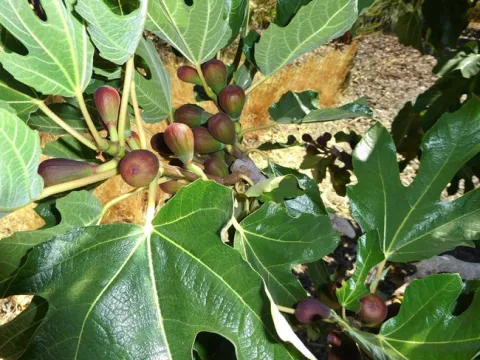
Plants We Love-Dwarf Fig Tree
by Leonard Cicerello UCCE Master Gardener
Ficus carica
Planting zone: Generally, 8-10 some varieties developed for zones 5-7. (USDA)
Tree size: Some dwarf varieties can grow to 15 feet tall by 15 feet wide. They do well in containers.
Harvest: Most bear two crops a year. The first comes in early summer on last year's wood; the second, and most important one, comes in late summer or early fall from the current year's growth.
Exposure: Full sun.
Pruning: Prune each winter to maintain the desired size. Cut back runaway shoots in any season. Eliminate crossing branches and dead wood.
Irrigation: Watering weekly during warm weather.
Description: Figs naturally grow to about the same height and width. They have large tropical looking leaves and they are not particular about soil. Home-garden figs do not need pollinating. Fertilize with low nitrogen fertilizer in early spring.
When figs are ripe, they detach easily when lifted and bent back toward the branch. Pick the fruit as it ripens and protect from birds if you can. In late fall, pick off the remaining ripe figs and clean up fallen fruit.
Here are five fig trees to consider:
'Black Jack'. The figs have purple skin with sweet pink flesh. It is similar to 'Mission' and it is widely adapted to California climates. It is easily kept small by pruning.
'Brown Turkey'. The figs have brownish purple fruit. It is adaptable to most fig-growing climates. It is a good, small garden tree.
'Celeste'. The figs have violet-tinged bronzy skin, and rosy amber flesh. They are good fresh, but dry well on the tree.
'Desert King'. This variety has one late-summer crop of green-skinned, red-fleshed fruit. It is adapted to all fig climates, but it will do better in cooler areas.
'Osborn Prolific' (Neveralla'). The figs have dark reddish-brown skin and amber flesh, which is often tinged pink. It is very sweet; It does best in Northern California coastal areas.

